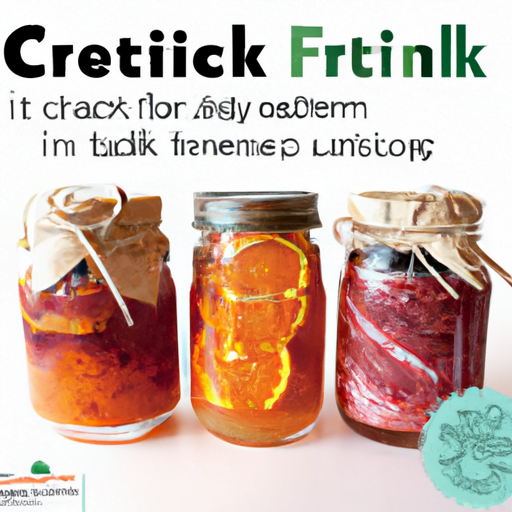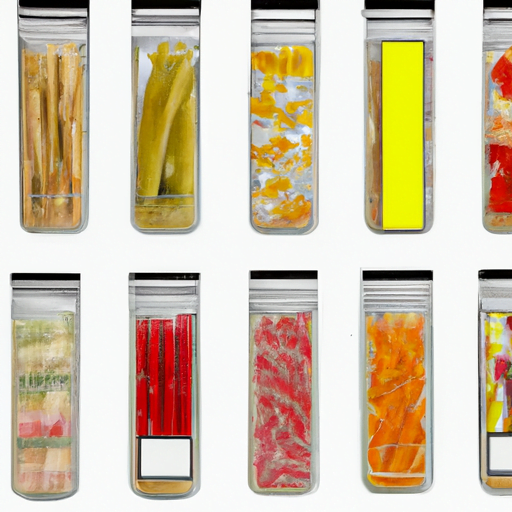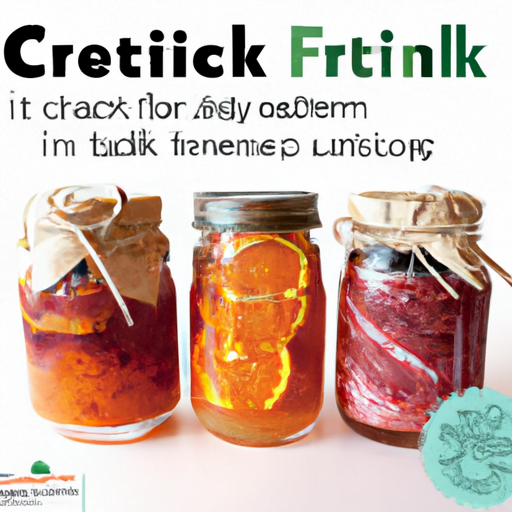So, you’re interested in off-grid living and thinking about ways to preserve food without relying on a freezer? Well, you’ve come to the right place! Freezing food is a convenient method, but it’s definitely not the only option out there. In this article, we’ll discuss seven alternative methods for food preservation that can come in handy when you don’t have access to electricity or a freezer.
From canning and pickling to dehydrating and fermenting, there are several techniques that have been used for centuries to keep food fresh for longer periods of time. These methods not only help extend the shelf life of your food but also allow you to enjoy your favorite fruits, vegetables, and even meats throughout the year, regardless of the season.
In the upcoming article, we’ll dive into the details of each method, explaining how they work and providing useful tips and tricks to get started. You’ll learn about the equipment needed, the steps involved, and the best types of food to preserve using each technique. Ready to explore the world of alternative food preservation methods? Stay tuned and get ready to become an expert in off-grid food storage!

7 Alternative Methods for Food Preservation
Off grid living can present its own set of challenges, especially when it comes to food preservation. Without the luxury of a freezer, you may wonder how you can effectively store food for long periods of time. Luckily, there are several alternative methods of food preservation that can help you overcome this obstacle. In this article, we will explore seven different techniques that you can use to preserve your food without relying on a freezer.
Canning
Canning is a tried and true method of food preservation that has been used for centuries. There are two main types of canning: water bath canning and pressure canning.
Water Bath Canning
Water bath canning is the simplest and most common method of canning. It is suitable for high-acid foods, such as fruits, jams, and pickles. To water bath can, you will need a large pot, canning jars with lids and bands, and a canning rack. Simply fill the pot with water, place the jars in the pot, and bring the water to a boil. Once the jars are processed for the recommended time, remove them from the pot and let them cool. The heat of the boiling water creates a vacuum seal, preserving the food inside.
Pressure Canning
Pressure canning is necessary for preserving low-acid foods, such as vegetables, meats, and soups. It uses a specialized pressure canner that reaches higher temperatures than a water bath canner. The higher temperatures are needed to safely kill any bacteria or spores that can cause spoilage. The process involves packing the jars with the food, sealing them, and processing them in the pressure canner for the recommended time. Once the jars cool and the pressure is released, they can be stored for long periods of time.
Pickling
Pickling is another popular method of food preservation that adds flavor to your foods. There are two main types of pickling: fermentation and vinegar-based pickling.
Fermentation
Fermentation is a natural process that involves using beneficial bacteria to preserve food. The most well-known fermented foods are sauerkraut and kimchi. To ferment vegetables, simply chop or shred them, add salt, and pack them tightly into a jar. The salt will draw out the natural juices, creating a brine that helps to preserve the vegetables. As the bacteria ferment the sugars in the vegetables, they produce lactic acid, which acts as a natural preservative. Fermented foods can be stored in a cool, dark place for several months.
Vinegar-based Pickling
Vinegar-based pickling is a quick and easy way to preserve foods, particularly fruits and vegetables. This method involves cooking the food in a mixture of vinegar, water, sugar, and spices, and then sealing it in jars. The vinegar acts as a natural preservative, helping to extend the shelf life of the food. The pickled foods can be stored in a cool, dry place for several weeks or months, depending on the acidity of the pickling liquid.
Smoking
Smoking is a traditional method of preserving meats and fish that imparts a unique and delicious flavor. There are two main types of smoking: cold smoking and hot smoking.
Cold Smoking
Cold smoking is a slow process that involves smoking food at temperatures below 100 degrees Fahrenheit. It is typically used for meats and fish that have been brined or cured beforehand. The smoke helps to preserve the food by inhibiting the growth of bacteria and other microorganisms. Cold smoked foods must be refrigerated or stored in a cool place, as the smoking process does not fully cook the food.
Hot Smoking
Hot smoking is a method of both cooking and preserving food. It involves smoking the food at temperatures between 125 and 250 degrees Fahrenheit until it is fully cooked. The combination of heat and smoke helps to kill any bacteria or parasites that may be present, ensuring the food is safe to eat. Hot smoked foods can be stored in the refrigerator for several days or frozen for longer storage.

Drying
Drying is one of the oldest methods of food preservation and can be done with or without electricity. There are two main types of drying: air drying and dehydration.
Air Drying
Air drying is a simple method that involves exposing the food to air until it is fully dehydrated. This can be done by hanging the food in a dry, well-ventilated area or by using a food dehydrator. Air drying works best for fruits, vegetables, herbs, and meats that have been salted or cured. The dried food should be stored in airtight containers in a cool, dry place.
Dehydration
Dehydration is a more efficient method of drying food that uses low heat and airflow to remove moisture. Electric food dehydrators are commonly used for this purpose, but you can also use an oven at a low temperature. Dehydrated foods are lightweight and can be stored in airtight containers for long periods of time. They can be rehydrated with water or added directly to soups and stews.
Salting
Salting is one of the oldest methods of food preservation and is commonly used for meats and fish. There are two main types of salting: dry salting and brine curing.
Dry Salting
Dry salting involves rubbing or sprinkling salt directly onto the food. The salt draws out moisture, creating an inhospitable environment for bacteria and other microorganisms. The salted food is then typically rinsed and air dried or smoked. Dry salted foods should be stored in a cool, dry place.
Brine Curing
Brine curing involves soaking the food in a saltwater solution, known as a brine. The saltwater helps to remove moisture from the food and creates a salty, flavorful product. Brine cured foods can be stored in the refrigerator for several weeks or canned for longer storage.
Fermentation
Fermentation is a versatile method of food preservation that can be used for a variety of foods. There are many fermented foods to choose from, but two popular options are sauerkraut and kimchi.
Sauerkraut
Sauerkraut is a fermented cabbage dish that is full of probiotics and beneficial bacteria. To make sauerkraut, simply shred cabbage and mix it with salt. Pack the cabbage tightly into a jar, making sure it is fully submerged in its own juices. Allow the cabbage to ferment at room temperature for a few days to several weeks, depending on your desired level of sourness. Once fermented, sauerkraut can be stored in the refrigerator for several months.
Kimchi
Kimchi is a traditional Korean dish made from fermented vegetables, spices, and seasonings. The most common variety is made with cabbage, chili peppers, garlic, and ginger. Like sauerkraut, kimchi is packed into a jar and left to ferment at room temperature. The length of fermentation will depend on your personal preference. Once fermented, kimchi can be stored in the refrigerator for several months.
Curing
Curing is a method of food preservation that involves using salt, sugar, or a combination of both to preserve and flavor the food. There are two main types of curing: salt curing and sugar curing.
Salt Curing
Salt curing involves covering the food in a layer of salt to draw out moisture and inhibit the growth of bacteria. This method is commonly used for preserving meats, such as ham and bacon. The salted meat is typically rinsed and air dried or smoked before being stored in a cool, dry place.
Sugar Curing
Sugar curing is similar to salt curing but uses sugar instead of salt. It is commonly used for preserving fish, such as salmon or trout. The sugar draws out moisture and helps to preserve the fish, while adding a slightly sweet flavor. Sugar cured fish should be rinsed and air dried before being stored in the refrigerator or freezer.
Jarring
Jarring is a method of food preservation that involves sealing food in jars to create a vacuum seal. There are two main types of jarring: water bath jars and vacuum sealing.
Water Bath Jars
Water bath jars are a simple and effective way to preserve high-acid foods, such as fruits, jams, and pickles. The food is packed into jars, sealed with lids and bands, and processed in a boiling water bath for the recommended time. The heat of the boiling water creates a vacuum seal, preserving the food inside. Water bath jars can be stored in a cool, dark place for several months.
Vacuum Sealing
Vacuum sealing is a method of removing air from a bag or container to create a tight seal. This method is often used in combination with other preservation techniques, such as drying or freezing. Vacuum sealed foods can be stored in the refrigerator or freezer for extended periods of time, as the lack of oxygen helps to inhibit the growth of bacteria and other microorganisms.
Root Cellar Storage
Root cellar storage is a traditional method of storing fruits, vegetables, and other perishable foods in a cool, dark, and humid environment. To prepare a root cellar, choose a location that is naturally cool, such as a basement or underground space. Insulate the walls, floor, and ceiling to maintain a consistent temperature and humidity level. Proper temperature and humidity control is crucial for successful root cellar storage, as it helps to slow down the natural ripening and decay process of fruits and vegetables. Rotate and inspect stored foods regularly to ensure they are still fresh and free from spoilage.
Conclusion
Living off grid doesn’t mean you have to sacrifice fresh and tasty food. By using alternative methods of food preservation, such as canning, pickling, smoking, drying, salting, fermentation, curing, jarring, and root cellar storage, you can preserve your food without the need for a freezer. Experiment with these techniques to discover new flavors and enjoy the satisfaction of self-sufficiency. With the right knowledge and preparation, you can enjoy homegrown and homemade foods all year round.




